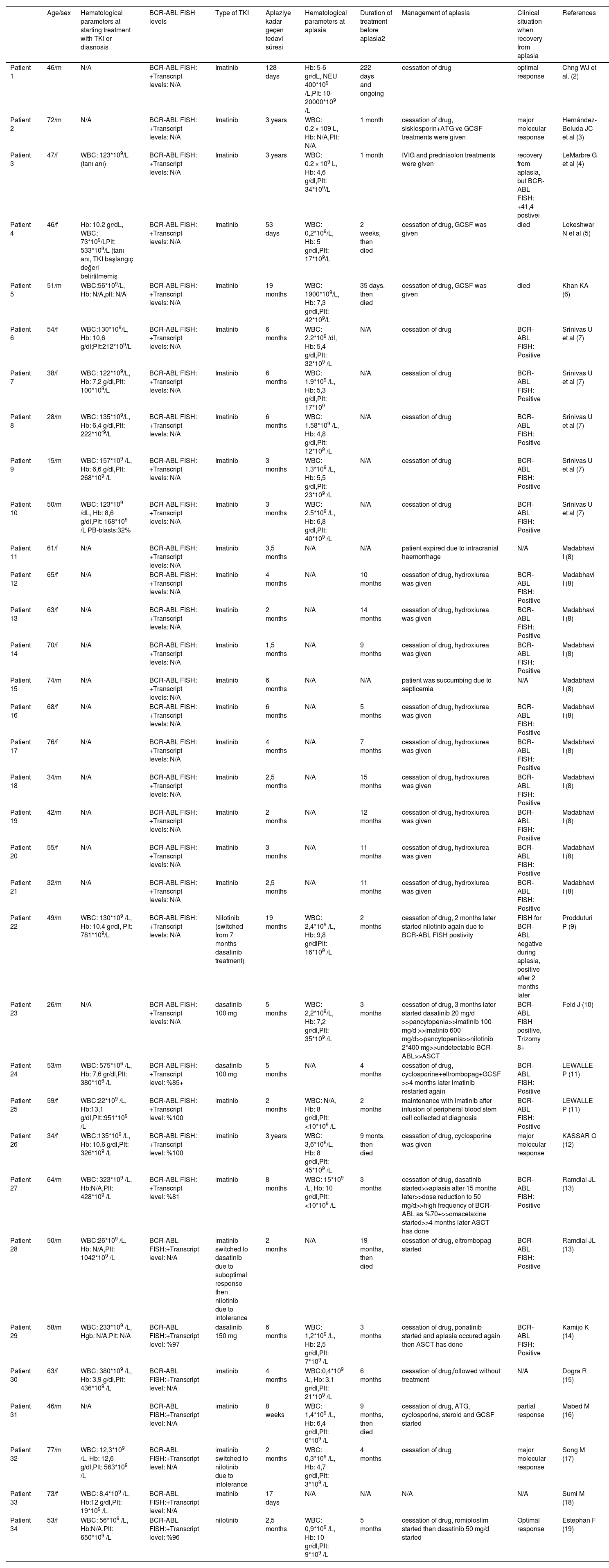
Hematology Specialist Association 18. National Congress
Mais dadosChronic myeloid leukemia (CML) is a malignancy classified under the group of chronic myeloproliferative neoplasms. It is characterized by uncontrolled leukocytosis, bleeding, thrombosis, recurrent infections, and hepatosplenomegaly. With the introduction of imatinib in 2001, followed by the second- and third-generation tyrosine kinase inhibitors (TKIs), a new era in the treatment of CML began, as overall survival rates have since reached levels comparable to normal life expectancy. In this article, we review the first case of aplastic anemia that developed after bosutinib treatment, along with other cases of aplastic anemia reported in the literature following the use of TKIs.
Case ReportA 57-year-old female was referred for leukocytosis identified during evaluation for fatigue, weakness, and early satiety. Initial lab results showed a WBC of 384 × 10⁹/L, NEU of 246 × 10⁹/L, Hb of 7.2 g/dL, and Plt of 281 × 10⁹/L. Abdominal ultrasound revealed splenomegaly (23 cm), and peripheral blood smear suggested chronic myeloid leukemia (CML), leading to BCR-ABL transcript testing. Hydroxyurea was initiated while awaiting results. Two weeks later, the BCR-ABL transcript level was 49%, and imatinib 400 mg/day was started on December 15, 2022.
The February 2023 earthquake disrupted the patient's imatinib use for three months. Upon return in May 2023, labs showed a WBC of 17 × 10⁹/L, NEU of 14 × 10⁹/L, Hb of 14.1 g/dL, Plt of 424 × 10⁹/L, and BCR-ABL remained at 49%. Imatinib was resumed. In August 2023, BCR-ABL decreased to 41%. However, in October 2023, pancytopenia emerged, leading to imatinib discontinuation (WBC: 2.98 × 10⁹/L, NEU: 0.5 × 10⁹/L, Hb: 4.1 g/dL, Plt: 2 × 10⁹/L). ABL mutation analysis showed no resistance mutations (Hemogram values at diagnosis and after treatment are shown in Figure 1).
After two weeks without medication and no improvement in pancytopenia, bone marrow biopsy confirmed aplastic anemia (Figure 2A). Following ten weeks of recovery, normocellular marrow was observed (Figure 2B), and dasatinib 50 mg/day was started on February 1, 2024, later increased to 100 mg/day. Due to worsening cytopenias in late February, dasatinib was reduced and eventually discontinued in March. Bosutinib 500 mg/day was initiated in May, with BCR-ABL at 27.9%. As cytopenias progressed, bosutinib was reduced to 300 mg/day. Despite a BCR-ABL decrease to 8.63% in August, cytopenias persisted, and bosutinib was further reduced 100 mg/day. The patient is currently being evaluated for allogeneic stem cell transplantation.
MethodologyUntil the 2000s, chronic myeloid leukemia (CML) was a fatal malignancy within the group of chronic myeloproliferative neoplasms. However, a significant breakthrough occurred following the approval of imatinib mesylate, the first tyrosine kinase inhibitor (TKI) for CML treatment, by the FDA in 2001 and the EMA in 2003. This was followed by the development of second-generation (dasatinib, nilotinib, bosutinib) and third-generation (ponatinib) TKIs, which greatly improved disease outcomes and significantly reduced TKI resistance.
Common side effects of TKIs include pleural/pericardial effusion, pretibial edema, hyperglycemia, hyperlipidemia, liver dysfunction, diarrhea, and thrombosis, most of which can be managed by temporarily discontinuing the drug or reducing the dosage. Transient myelosuppression is also a frequently observed side effect of TKI therapy. However, prolonged aplastic anemia (AA) is a rare adverse effect secondary to TKIs. To date, cases of bone marrow aplasia associated with imatinib, dasatinib, and nilotinib have been reported in the literature, and the approaches to managing these cases are summarized in Table 1.
Common management strategies include discontinuation of the drug, observation without medication, switching to another TKI, or performing allogeneic stem cell transplantation. Additional treatments such as cyclosporine, antithymocyte globulin (ATG), and filgrastim have also been employed. Unfortunately, despite various interventions, some patients have succumbed to septic mortality associated with prolonged neutropenia and intracranial hemorrhage linked to thrombocytopenia. The small number of cases makes it challenging to establish a standardized treatment approach.
The mechanism of TKI-induced aplastic anemia (AA) remains unclear, but four potential pathophysiologies are considered: 1) acellularity in the hematopoietic system due to bone marrow infiltration by the CML clone [19], 2) blastic evolution during treatment [13], 3) suppression of hematopoietic stem cell proliferation through inhibition of kinases like c-kit, PDGFR, and SRY [8], and 4) toxic drug levels due to genetic polymorphisms in drug metabolism [20]
ResultsStudies have shown that higher doses of TKIs are associated with increased rates of myelosuppression [21]. Since routine monitoring of drug levels is not available in many healthcare facilities, using lower-than-standard TKI doses may be a viable alternative in cases of prolonged, severe cytopenias. In our patient, the progressive decline in BCR-ABL transcript levels suggests that the cause of AA is more likely due to nonspecific suppression of hematopoietic stem cells by TKIs rather than blastic evolution.
Due to the unavailability of drug level testing at our center, we could not rule out bone marrow suppression related to drug toxicity. However, our patient tolerated bosutinib better, with the BCR-ABL transcript level dropping below 10% for the first time, distinguishing bosutinib from other TKIs. The milder cytopenic profile observed may be related to bosutinib's weaker inhibition of PDGFR and c-kit [22].
ConclusionIn cases of aplastic anemia following TKI therapy, various case-based treatment approaches exist, but no standardized method has been widely accepted. During the TKI era, allogeneic stem cell transplantation remains a necessary option for CML patients with AA. Asciminib, with its distinct mechanism of action, could be considered a treatment option in such cases, though no data currently exist in the literature. While the patient's BCR-ABL transcript level after bosutinib 100 mg/day is eagerly awaited, lower-dose bosutinib may present a viable alternative for this patient group.
Figure 1
Figure 2: A) Bone marrow biopsiy demonstrating loss of cellularity following imatinib-associated pancytopenia. B) Bone marrow biopsy showing increased cellularity performed 10 weeks after discontinuation of imatinib.
Table 1: Cases of aplastic anemia secondary to tyrosine kinase inhibitors reported in the literature to date











